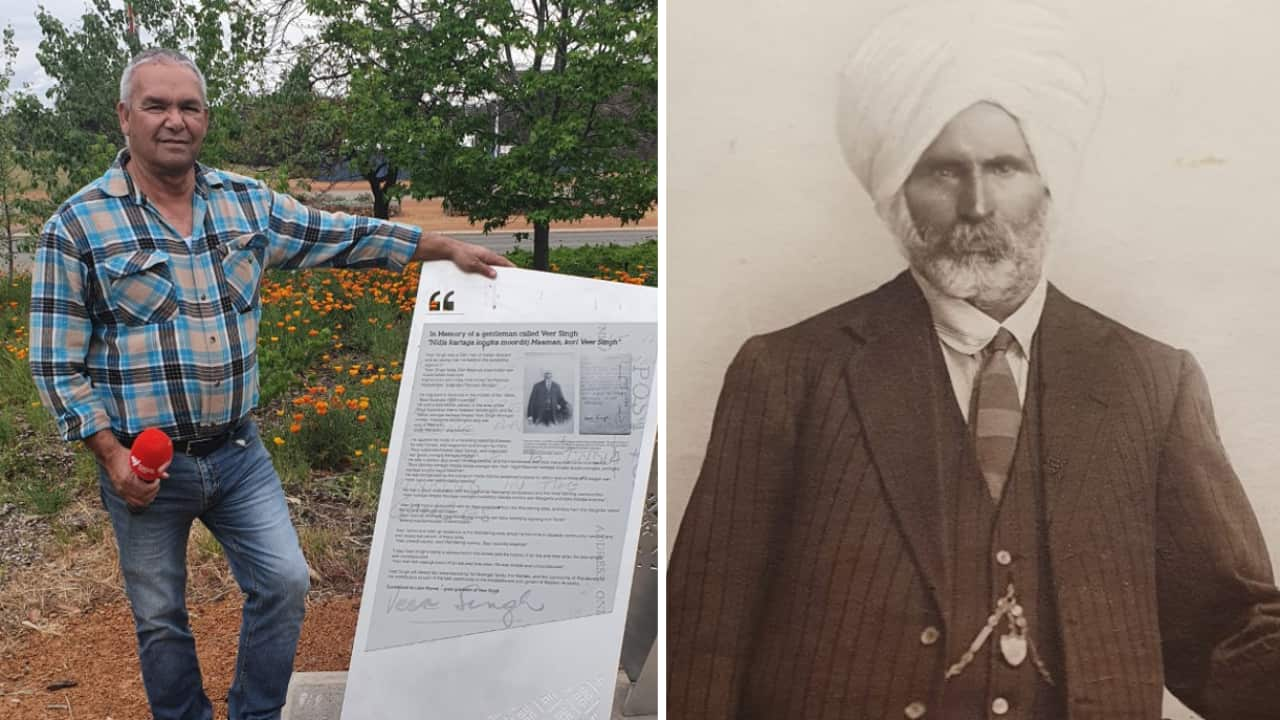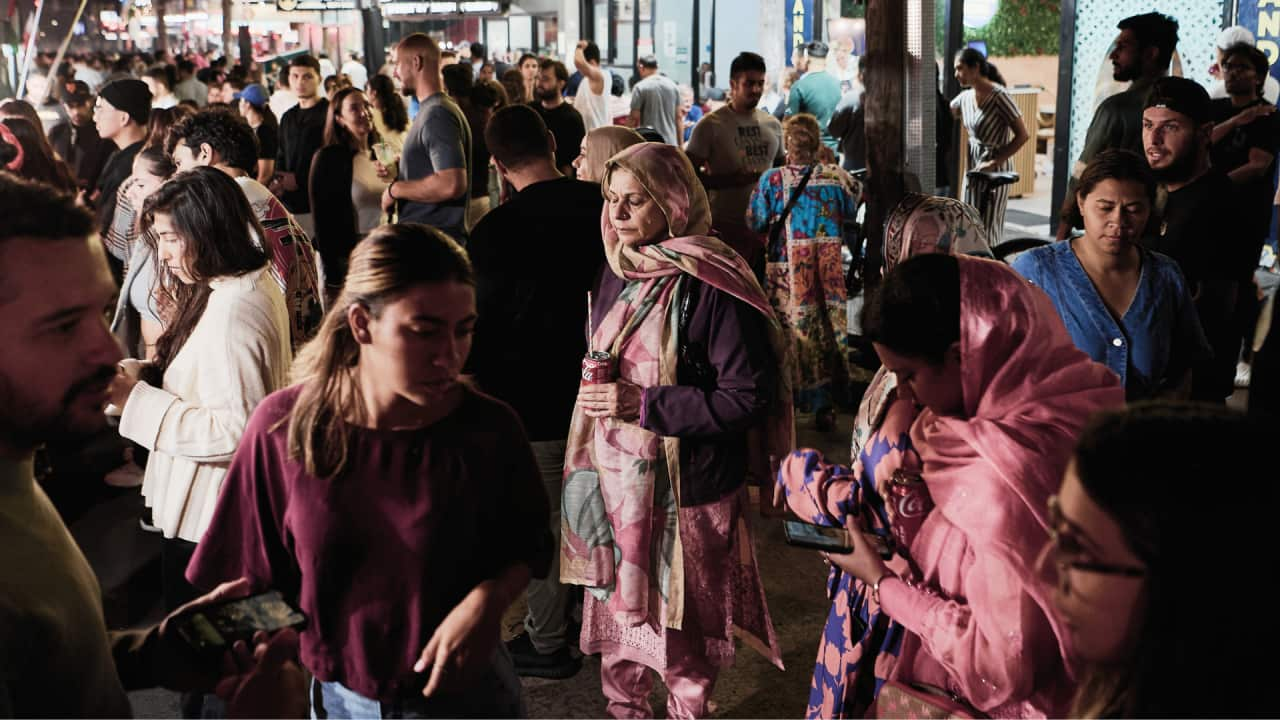Key Points
- Veer Singh migrated from Punjab in the late 19th century.
- He was a hawker who later settled in Wandering in Western Australia.
- Mr Singh was in a relationship with a local Aboriginal woman and had a daughter named Sarah.
Veer Singh migrated from Punjab around 1897 when Western Australia entered a boom period brought about by the discoveries of gold.
To Mr Singh and many of his fellow compatriots, Australia at the time seemed like a land of opportunity. But for the locals, they were guest labourers and were forbidden to bring wives or family.
As a hawker who traded various goods, Mr Singh soon found footing in the Wandering district.
Like many early settlers, he was a sojourner who used to travel between Perth and Wandering and other adjacent towns to sell his merchandise on foot.
But after amassing a small fortune, Mr Singh bought a small horse-drawn wagon to reach out to remote settlers who lived miles away from towns and shops.

Veer Singh in a picture alongside horses and a cart in the background. Credit: Supplied
After becoming a man of standing, he got into a relationship with a local Aboriginal woman and had a daughter from the alliance.
'I am proud of my heritage'

Leon Wynne at the Wandering Sikh Memorial site with his partner. Source: SBS / Preetinder Grewal
"When I saw my family tree, it linked me back to Veer Singh. He was living in Wandering and had a relationship with an Aboriginal lady. From that relationship, he had a daughter named Sarah, who ended up marrying an Aboriginal man.
"His name was Naragul, who became English after a while and became Narkle that, gave the family an English surname," he said.

Veer Singh of Wandering. Credit: Supplied
"This is because there is no V in the Aboriginal vocabulary, so the Noongars know him as Bir Singh instead of Veer Singh."
Mr Wynne said Mr Singh enjoyed a good relationship with the traditional Aboriginal landowners and the local farming communities in the Wandering area.
"I am proud of my heritage. We respect this old man. He was well-respected by the Aboriginals and the local people because he traded a lot with them," he said.
He never looked down upon Aboriginal people. He moved with them when they moved, so he moved in their times.Leon Wynne
According to Albert Schorer's book 'The Horses Came First,' Mr Singh made two trips back to India. On one of these trips, he lost his fortune and turned to his friends, the European Dowsett family, for assistance, who lent him the money to make a return journey.
"After some time, Veer refunded the family for their (Dowsett family) assistance and regularly sojourned at their property," the book quotes.
According to the same book, Mr Singh was so loved within the community that on his 80th birthday, the Dowsetts threw him a party with over 170 people attending the event.
Racial discrimination and marginalisation

Dr Dirk Spennemann is a cultural heritage expert with Charles Sturt University. Credit: Supplied
Dr Dirk Spennemann, a cultural heritage expert with Charles Sturt University who studied the journey of young men like Mr Singh from the Punjab region across south-eastern Australia in the 1800s, told SBS Punjabi that Indians brought the practice of funeral cremation to Australia.
He said the practice became a subject of a heated public debate during the times.
"The Indian community had no choice. A deceased Hindu or Sikh had to be cremated full stop, and that led to literally roadside cremations at the beginning where fellow Indian hawkers would congregate, prepare the body, erect the funeral pyre, put various types of fuel and then light the pyre," he explained.
Dr Spennemann said that many Indians who came as hawkers later used the economic opportunities to revive their farming past and successfully acquired land, becoming ratepayers and landowners.
They were, however, subjected to racial prejudice and faced marginalisation, he added.
"It was assumed that Australian women would be threatened by these virile young men. But despite the racism, the hawkers made a living because they provided a vital intermediary service between country towns and outlying," he said.
'Veer Singh's story is enormously important and relevant for Sikhs in Australia'

Tarun Preet Singh is a volunteer with the Sikh Association of Western Australia (SAWA). Source: SBS / Preetinder Grewal
Tarun Preet Singh, a volunteer with the Sikh Association of Western Australia (SAWA) who was instrumental in unearthing Mr Singh's story, said his immigration journey is enormously important and relevant for Sikhs in Australia and the rest of the world.
"This is not just a story but a factual account of a man who is very important for our future generations and people in Australia," he said.
"This plaque is unique to my knowledge so far where a Sikh or Indian story has been written in any first nation language - the Noongar/Nyungar language in Australia."
It's important to tell these stories, so people in Australia know about the valuable contribution that our ancestors made to the development of the Australian multicultural society.Tarun Preet Singh, volunteer, Sikh Association of Western Australia (SAWA)
Veer Singh had migrated to Australia from Ghull Kalan village situated near Moga in Punjab around 1897.
On 30 April 2022, SAWA, along with the Shire of Wandering, inaugurated a memorial to commemorate the Sikh hawkers and the region's cultural diversity.
Click on the audio icon to listen to Veer Singh's story:
LISTEN TO

Veer Singh, the Indian hawker who lived, loved and left a lasting legacy in Wandering
SBS Punjabi
11:23





